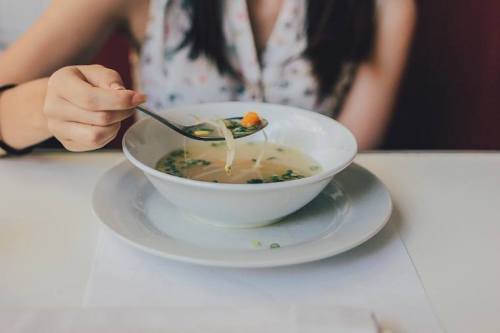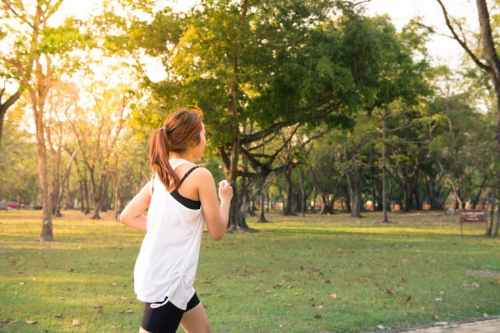Our editors independently select these products. Making a purchase through our links may earn Well+Good a commission
Your Turkey Day game plan for banishing bloat
Soothe your post-feast bloat with these expert tips and workout moves.

Within twenty minutes of tucking into your Thanksgiving feast, you’ve polished off a turkey leg, an impressive amount of Brussels sprouts, and a tasty helping of avocado-stuffed acorn squash (because #avocadoeverydamnday is a lifestyle). But going from famished to stuffed isn’t exactly comfortable—even if you planned your outfit with hygge in mind. The bloat starts to creep in and, suddenly, that slice of (gluten-free) pumpkin pie you’ve been dreaming of since September has lost its luster.
Finding relief after overindulging on Thanksgiving is all about strategy—i.e. a three-pronged attack that includes steps you can take before, during, and after the main meal. Below, Robynne Chutkan, MD, a gastroenterologist and author of The Bloat Cure, shares her best practices for keeping things regular this Thanksgiving. Plus: Jeff Bell, co-founder and fitness expert at Belleon Gym in New York City, provides four moves to speed up the digestion process.
Keep reading for your complete guide to relieving post-Thanksgiving bloat.

Before dinner
Thanksgiving mornings are for turkey-trotting, Harry Potter marathons, and slothing around in your most luxe pajamas. But according to Dr. Chutkin, they’re also the ideal time to start prepping your body for an afternoon of feasting.
“How efficiently things move through the GI tract has a lot to do with what else is in the GI tract,” says Chutkin. “When the colon’s full, it tends to send a chemical message to the upper GI tract that says, ‘We’re really full down here. Don’t send a bunch of stuff down.’ That can result in bloating.” To clear the path for a large mid-afternoon meal, Chutkin says to fuel the days leading up to Thanksgiving with salads, smoothies, and soups (like this 20-minute detoxer).
Chutkin also notes that fasting pre-meal is a big no-no. “I don’t recommend fasting all day because you’re just naturally going to eat more at one sitting than you should, rather than spreading it out a little bit,” she says.
Another pro tip: Use your circadian rhythm to time the meal. Why? Your digestive system syncs with the sun. “Once that sun sets, the stomach really does not move very much. And unfortunately, what time you eat Thanksgiving dinner, not just how much, plays a role in whether you end up bloated,” says Dr. Chutkin. Lesson learned: Opt for an earlier feast.

During dinner
Now that you’ve readied your gut for a burst of fall flavors, you’re set to start eating. Dr. Chutkan suggests grabbing a smaller plate to start. “If you have two servings on a salad plate, that’s probably one regular serving on a dinner plate,” she says.
If you typically adhere to a gluten-free, vegan, or Paleo diet, come Thanksgiving, it’s easy to throw caution to the wind (especially if you’re trying to make things easier on your host). But Dr. Chutkin says it’s smarter to stick to your regular routine. “[The food] goes down pretty well, but you don’t feel as well after,” says Dr. Chutkin. So if you’re GF, for instance, and know you’ll be craving a roll with your supper, BYO is the name of the game.
In addition to watching what you eat, you should pay attention to what’s filling your glass. Champagne toasts are right at home at Thanksgiving dinner, but according to Dr. Chutkin, you might want to save your santés for post-pie. “The bubbles can really bloat you. If you’re prone to bloating— and it’s a late meal, and it’s higher fat—some sort of sparkling beverage can end up being a problem.”

Right after dinner
Oops. Well, thanks to an extra scoop or two of sweet potatoes, the bloat has crept in. It’s time for damage control.
First things first: Get up and get moving. After feasting, you may feel tempted to lie on the couch for the foreseeable future. But resist! “Light exercise after [eating], like walking, is a great way to stimulate peristalsis,” says Dr. Chutkan. So round up the fam for a neighborhood stroll.
If you feel like everything’s just kind of, er, sitting in your stomach, Dr. Chutkin suggests taking a magnesium supplement: “That’s not going to help acutely with the bloating, but that’s going to help with laxation.”

3 to 4 hours after dinner
Once the game wraps up and you’ve headed home with a week’s worth of leftovers, it’s time to turn your attention back to your body. Bell says that three to four hours after your last bite is your optimal window for squeezing in a few moves to stimulate your gastric juices. “Movement or exercise that activates your core with twisting is really great to move along digestion,” he says.
Here’s a quick sequence you can do on the living room floor. For an extra boost, Bell suggests pairing this sequence with a quick jog or bike ride.
Renegade Row: Assume a pushup position—feet hip-width apart, hands directly beneath your shoulders—with a dumbbell in each hand. Stabilize your core by pulling your navel in. One at a time, pull the right dumbbell up towards your rib cage on one side, then you lower it back down. Repeat with the left arm. Think about keeping your pelvis and hips very stable and still. Once you’ve done both arms, take your right knee to tap your left forearm or elbow. Then tap your left knee to your right forearm or elbow. Repeat 15-30 times.
The Lizard: Assume a pushup position with your knees slightly bent in the back. Reach forward with your right arm while lifting your left leg straight up behind you (mimicking the tail of a lizard). As you reach your right arm forward toward the floor, quickly lift your left leg up and snap it out to the side. Make sure your hips aren’t piking up in the air; keep them level. Place your foot on the floor right behind your left hand and your left knee behind your left elbow. Repeat on the other side. Do 15-30 reps on each side.
Trunk Twists: Grab a medicine ball. Sit on the floor like you’re about to do sit-ups. Sit half-way up with your legs either on the ground or slightly in the air with semi-bent knees. Hold the medicine ball while you’re balancing your upper body in the air. While holding the ball in your hand, twist the trunk to the right and tap the floor. Do 15-30 reps on each side.
The Monkey Crawl: Squat down and place your hands on the floor in front of you (like a monkey). Make sure your hands are about shoulder-width apart and your feet can be anywhere from hip-width apart to almost double that width. Shift your weight slightly forward, reach your arms to the right diagonally, and place them on the floor. Plant your weight on your arms and then shift and lift your legs up slightly in the air, then to the right beyond your hands. Do 15-30 reps on each side.

The next day
There’s nothing like a good Thanksgiving hangover to revamp your commitment to wellness. So if you wake up on November 24th with a protruding stomach and a bout of lethargy, Dr. Chutkan says don’t sweat it. Take it as an opportunity to note the contrast between how you feel when you treat your body well and how you feel when you, let’s say, overdo it.
When you first wake up, fill your favorite water bottle (preferably liter-sized). “The beginning of the day is a great time to hydrate,” says Dr. Chutkan. She recommends drinking one to two liters right away, on an empty stomach. “Your Thanksgiving dinner might be stuck half-way between your mouth and the toilet bowl—somewhere in your small intestines or the top of your colon. You’re literally just washing it through, washing it down,” she says.
More fluids follow throughout the day: Dr. Chutkan recommends fixing yourself a spot of fennel tea, which will provide the digestive support you need after an enormous influx of calories. After your morning run, heat up some water and snuggle up with these four family-friendly Netflix picks.
Now that your gut is happy, keep the good vibes flowing with a sage and palo santo cleanse and a one-minute gratitude break courtesy Gabrielle Bernstein.
Sign Up for Our Daily Newsletter
Get all the latest in wellness, trends, food, fitness, beauty, and more delivered right to your inbox.
Got it, you've been added to our email list.










